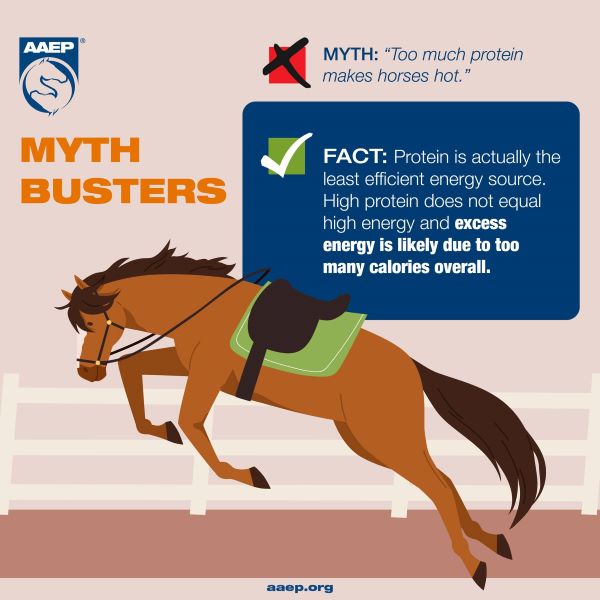Mythbusters from AAEP: Horses and Protein
From the AAEP Horse Owner Education Committee:
Although protein is normally listed as a nutrient, horses actually have a requirement for amino acids, the building blocks of protein, rather than for protein itself. Protein is the least efficient energy source for your horse, so high protein does not automatically equal high energy. Carbohydrates, fats, and fiber are more readily digestible energy sources, so chances are a horse with too much energy is being fed more calories than the animal truly needs.
As always, remember that all horses have different nutritional needs based age, stage of development, metabolism and workload. Be sure to work with your veterinarian to determine the correct protein and energy requirements for your equine friend based on your horse’s individual situation!
Learn more below in an excerpt below from the AAEP article Nutrition: The Key to Unlocking Your Horse’s Health by Lydia Gray, DVM, MA, Staff Veterinarian/Medical Director, SmartPak:
KEY #6–The Six Classes of Nutrients
Nutrients are divided into six categories: water, protein, carbohydrate, fat, vitamins and minerals. All are essential to life, but water is usually listed first because animals can survive without the other nutrients longer than they can survive without water, as 70-75% of the body consists of water. The two main functions of water are as a component of metabolism and a factor in body temperature control. Generally, horses drink between 5 – 15 gallons per day, depending on their size, the environment, their workload and other factors. The best advice is to always have clean, drinkable water available at all times.
Although protein is listed here as a nutrient, horses actually have a requirement for amino acids, the building blocks of protein, rather than for protein itself. According to the NRC’s Nutrient Requirements of Horses, the adult horse in minimum work that weighs just over 1000 pounds needs 540 total grams of protein in its diet per day. Another way of saying this is that the diet should contain 8% protein. Next to water, protein is the most abundant substance in the body, making up not just muscle but also connective tissue such as skin, hooves and hair, as well as enzymes, hormones and other substances. Proteins are commonly made of 20 amino acids but only 10 of these are considered essential, meaning they must be supplied in the diet because the animal cannot make them itself. Lysine is considered the first “limiting” amino acid because if it is not present in adequate amounts, the body’s ability to manufacture proteins is limited.
Carbohydrates mainly serve as an energy source for horses, but their fiber component is also necessary to keep the large intestine moving and functioning properly. There are many ways to categorize carbohydrates and all of them are somewhat confusing. One method is to divide them between structural and non-structural carbohydrates (NSC). Structural carbohydrates include the completely indigestible lignin–which passes through the horse’s digestive tract unchanged– as well as cellulose and hemi-cellulose, insoluble fibers that can only be digested by bacteria that live in the colon. Non-structural carbohydrates include single sugars like glucose (monosaccharides), double sugars like lactose (disaccharides), medium-length sugars like fructoligosaccharide (also known as FOS), and longer sugars like starch (polysaccharides).
Interestingly, a requirement for fatty acids in the horse has not been established, although nutritionists suggest the diet contain at least 0.5% linoleic acid, an omega 6 fatty acid. Recent studies have shown that supplementing with omega 3 fatty acids may down-regulate inflammation in the body, especially in the skin and respiratory system. Fat is necessary for cell membrane health, as a carrier for fat-soluble vitamins out of the GI tract, and as a precursor to prostaglandins. However, research has shown other benefits to adding fat to the diet, up to 20% on a dry matter basis. Because it is more energy-dense than carbohydrates, fat can provide additional calories to the hard-working horse or the thin horse that needs to gain weight. Fat as an alternative source of energy to the simple carbohydrates found in grain leads to less excitability and improved efficiency.
Vitamins are organic elements required in small amounts in the diet by the body for essential metabolic functions to prevent overt signs of disease. They are divided into two kinds: the fat soluble A, D, E and K and the water soluble B-vitamins and Vitamin C. Because the horse can make some of the vitamins it needs (some B-vitamins, C, D and K), not all are required in the diet under normal circumstances. However, senior horses with less efficient systems or any horses undergoing stress from injury, illness, transport, or GI conditions that may interfere with normal gut flora may require supplementation.
Minerals are inorganic elements recognized to perform essential functions in the body and must be present in the diet. They are also divided into two kinds: the macrominerals which are required in larger amounts than the micro or trace minerals. Macrominerals include Sodium (Na), Chloride (Cl), Calcium (Ca), Phosphorus (P), Magnesium (Mg), Potassium (K) and Sulfur (S). Microminerals include Cobalt (Co), Copper (Cu), Iodine (I), Iron (Fe), Manganese (Mn), Selenium (Se) and Zinc (Zn). Other minerals of interest include Chromium (Cr), Fluorine (F) and Silicon (Si).
Read the entire piece by By Lydia Gray, DVM, MA, Staff Veterinarian/Medical Director, SmartPak, here:











